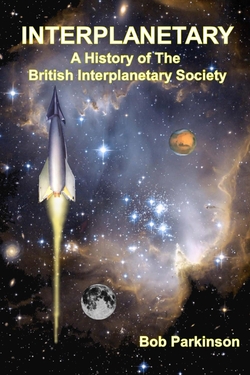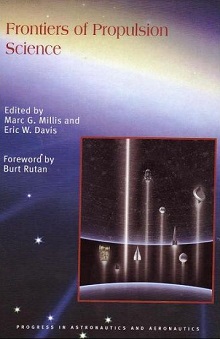Centauri Dreams
Imagining and Planning Interstellar Exploration
Shifting Ice on Enceladus
We could do with more information about how ice behaves on a gas giant’s moon. We’ll need this knowledge to understand the behavior of crustal ice on places like Europa and Enceladus, where oceans may provide sub-surface venues for life. One approach into the subject is to look at ice right here on Earth; specifically, the Antarctic ice shelves. A new study out of NASA’s Goddard Space Flight Center applies a model based on Antarctic data to the fractured south pole of Enceladus, probing tidally driven stress and seismic activity within an ice shell.
We assume that tidal stresses produced by the moon’s interactions with Saturn, as well as the planet’s larger moons, keep the interior of Enceladus warm, while at the same time producing cracks and accounting for the geysers of water vapor Cassini found erupting from the so-called ‘Tiger Stripes’ (fractures) at the southern pole. The tides of Enceladus must be massive, and learning about the seismic activity they induce offers a key to the movement of the ice.
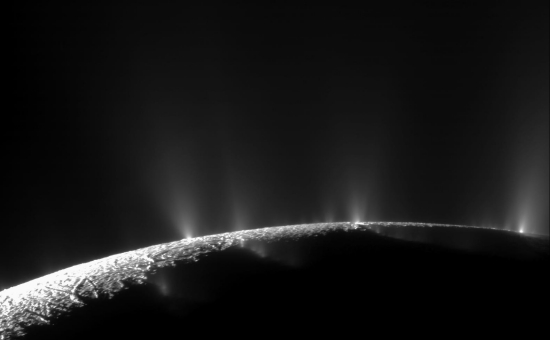
Image: Dramatic plumes, both large and small, spray water ice and vapor from many locations along the famed “Tiger Stripes” near the south pole of Saturn’s moon Enceladus. The Tiger Stripes are four prominent, approximately 84-mile- (135-kilometer-) long fractures that cross the moon’s south polar terrain. Credit: NASA/JPL/Space Science Institute.
Future lander missions will benefit from knowing where and when icequakes occur on Enceladus. Led by Kira Olsen (NASA GSFC), the research effort described in the Journal of Geophysical Research: Planets focuses on data collected by seismometers deployed along Antarctica’s Ross Ice Shelf between 2014 and 2016, with an eye toward examining the tensile strength of the ice and the stresses on it. The researchers compared these data with satellite imagery of the same area.
They found that most icequakes on the Ross Ice Shelf happened as large rifts in the ice pulled apart, which occurs in conditions of falling tides. The team used the Antarctic data to produce models of seismic activity on Enceladus, having observed that “seismic activity at the Antarctic rifts is sensitive to both the amplitude and the rate of tensile stress across the rifts.”
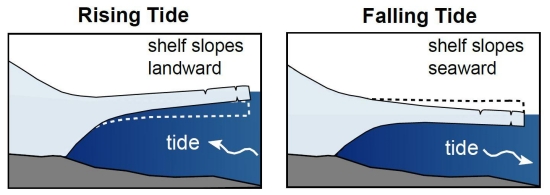
Image: Ice shelves floating on Earth’s Southern Ocean rise and fall with tides, causing rifts, fractures. Icequakes occur most frequently when falling tides pull the rifts apart. Models suggest seismic activity on Enceladus likely corresponds to the tides inside the moon. From figure 1 of the new study. Credit: AGU/ JGR: Planets.
The paper makes the case that the similarities between Antarctica and Enceladus are strong, homing in on a pair of interior, parallel fractures in the central part of the Ross Ice Shelf:
These internal rifts, named WR4 and WR6 (for Western Ross rifts 4 and 6; e.g., Walker et al., 2013), exist within a geophysical environment closely analogous to the TSF(Tiger Stripe Fractures) within the Enceladean icy shell. Physical similarities include (1) the Antarctic rifts are concentrated regions of deformation within the ice shelf, as are the TSF within Enceladus’ ice shell, (2) the Antarctic rifts undergo daily cycles of tidal deformation, similar in time scale to the tidal cycle that the TSF undergo throughout an Enceladean orbit (?33 h), (3) the Antarctic rifts share similar geometries with the TSF (Table 1), and (4) fracture mechanics and seismicity generation is expected to be similar between the Antarctic and Enceladean environments.
The authors combined the Antarctic data with calculated stress values along Enceladus’ Tiger Stripes to predict seismic-activity levels along the ice-shell fractures. The result: Seismic activity on Enceladus should peak when the moon is 90°–120° past the closest approach in its orbit around Saturn, with seismic activity levels decreasing by about 50 percent during the last 180° of the orbit. The activity along the cracks, according to the model, should not be massive, but rather a series of small movements and fractures producing sustained stress on the ice, consistent with our observations of plume eruptions at the Tiger Stripes, which tend to be discrete rather than simultaneous ‘curtain eruptions’ along an extended fracture segment.
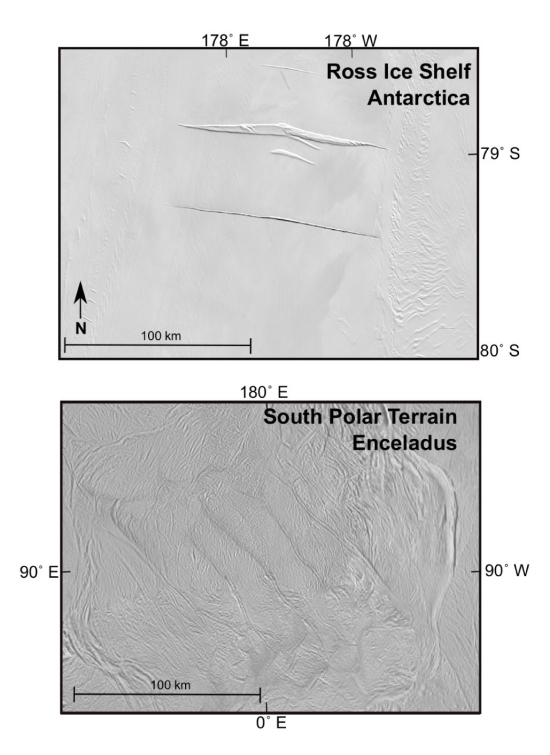
Image: A satellite image of the research study site on the Ross Ice Shelf in Antarctica (top) shows two rifts in the ice from rising and falling tides. Similarly sized “Tiger Stripe fractures” crease the ice in Enceladus’ South Polar Terrain, in an image captured by the Cassini Imaging Team. Also from figure 1 of the new study. Credit: AGU/ JGR: Planets.
A useful approach, according to the authors, would be for any future mission to Enceladus to place seismometers within 10 kilometers of these fractures. For now, while Europa is in our thinking with the upcoming Europa Clipper and JUICE missions, no Enceladus missions are in the works. But the scientists see their model offering insights into other icy moons:
Though we focus this study on Enceladean rifts, the relationship that we observed at the Ross Ice Shelf rifts between tensile stress, stretching rate, and seismic activity could be applicable to tidally forced seismicity in other planetary settings. The key input needed would be robust models of stress evolution through an orbital cycle at the fracture locations of interest. Future work applied to Titan would be especially insightful, given the collection of on-ice seismic data planned as part of the Dragonfly mission. Observation and study of the energy generated by icequakes will be one of the primary ways such missions to icy worlds advance our understanding of a range of scientific goals, from better understanding tidal tectonics, surface deformation, cryovolcanism, and material properties, to seismically probing the structure of the ice and sub-ice interior. Our study demonstrates the utility of even a single seismograph for these future missions.
The paper is Olsen et al., “Projected seismic activity at the tiger stripe fractures on Enceladus, Saturn, from an analog study of tidally modulated icequakes within the Ross Ice Shelf, Antarctica,” JGR: Planets 21 May 2021 (full text).

Notes on the Magnetic Ramjet II
Building a Bussard ramjet isn’t easy, but the idea has a life of its own and continues to be discussed in the technical literature, in addition to its long history in science fiction. Peter Schattschneider, who explored the concept in Crafting the Bussard Ramjet last February, has just published an SF novel of his own called The EXODUS Incident (Springer, 2021), where the Bussard concept plays a key role. But given the huge technical problems of such a craft, can one ever be engineered? In this second part of his analysis, Dr. Schattschneider digs into the question of hydrogen harvesting and the magnetic fields the ramjet would demand. The little known work of John Ford Fishback offers a unique approach, one that the author has recently explored with Centauri Dreams regular A. A. Jackson in a paper for Acta Astronautica. The essay below explains Fishback’s ideas and the options they offer in the analysis of this extraordinary propulsion concept. The author is professor emeritus in solid state physics at Technische Universität Wien, but he has also worked for a private engineering company as well as the French CNRS, and has been director of the Vienna University Service Center for Electron Microscopy.
by Peter Schattschneider

As I mentioned in a recent contribution to Centauri Dreams, the BLC1 signal that flooded the press in January motivated me to check the science of a novel that I was finishing at the time – an interstellar expedition to Proxima Centauri on board a Bussard ramjet. Robert W. Bussard’s ingenious interstellar ramjet concept [1], published in 1960, inspired a generation of science fiction authors; the most celebrated is probably Poul Anderson with the novel Tau Zero [2]. The plot is supposedly based on an article by Carl Sagan [3] who references an early publication of Eugen Sänger where it is stated that due to time dilation and constant acceleration at 1 g „[…] the human lifespan would be sufficient to circumnavigate an entire static universe“ [4].
Bussard suggested using magnetic fields to scoop interstellar hydrogen as a fuel for a fusion reactor, but he did not discuss a particular field configuration. He left the supposedly simple problem to others as Newton did with the 3-body problem, or Fermat with his celebrated theorem. Humankind had to wait 225 years for an analytic solution of Newton‘s problem, and 350 years for Fermat’s. It took only 9 years for John Ford Fishback to propose a physically sound solution for the magnetic ramjet [5].
The paper is elusive and demanding. This might explain why adepts of interstellar flight are still discussing ramjets with who-knows-how-working superconducting coils that generate magnetic scoop fields reaching hundreds or thousands of kilometres out into space. Alas, it is much more technically complicated.
Fishback’s solution is amazingly simple. He starts from the well known fact that charged particles spiral along magnetic field lines. So, the task is to design a field the lines of which come together at the entrance of the fusion reactor. A magnetic dipole field as on Earth where all field lines focus on the poles would do the job. Indeed, the fast protons from the solar wind are guided towards the poles along the field lines, creating auroras. But they are trapped, bouncing between north and south, never reaching the magnetic poles. The reason is rather technical: Dipole fields change too rapidly along the path of a proton in order to keep it on track.
Fishback simply assumed a sufficiently slow field variation along the flight direction, Bz=B0/(1+ ? z) with a „very small“ ?. Everything else derives from there, in particular the parabolic shape of the magnetic field lines. Interestingly, throughout the text one looks in vain for field strengths, let alone a blueprint of the apparatus. The only hint to the visual appearance of the device is a drawing of a long, narrow paraboloid that would suck the protons into the fusion chamber. As a shortcut to what the author called the region dominated by the ramjet field I use here the term „Fishback solenoid“.
Fig. 1 is adapted from the original [5]. I added the coils that would create the appropriate field. Their distance along the axis indicates the decreasing current as the funnel widens. Protons come in from the right. Particles outside the scooping area As are rejected by the field. The mechanical support of the coils is indicated in blue. It constitutes a considerable portion of the ship’s mass, as we shall see below.
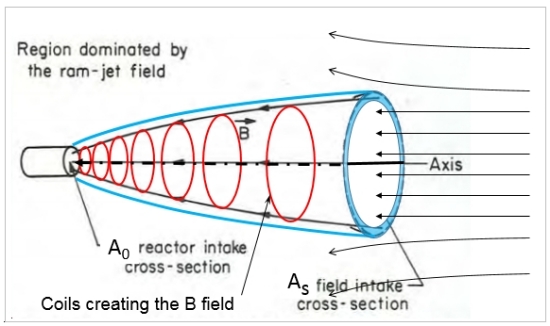
Fig. 1: Fishback solenoid with parabolic field lines. The current carrying coils are symbolized in red. The mechanical support is in blue. The strong fields exert hoop stress on the support that contributes considerably to the ship’s mass. Adapted from [5].
Searching for scientific publications that build upon Fishback’s proposal, Scopus renders 6 citations up to this date (April 2021). Some of them deal with the mechanical stress of the magnetic field, another aspect of Fishback’s paper that I discuss in the following, but as far as I could see the paraboloidal field was not studied in the 50 years since. This is surprising because normally authors continue research when they have a promising idea, and others jump on the subject, from which follow-up publications arise, but J. F. Fishback published only this one paper in his lifetime. [On Fishback and his tragic destiny, see John Ford Fishback and the Leonora Christine, by A. A. Jackson].
Solving the dynamic equation for protons in the Fishback field proves that the concept works. The particles are guided along the parabolic field lines toward the reactor as shown in the numerical simulation Fig. 2.
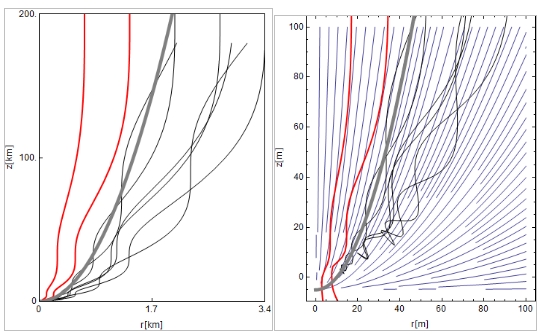
Fig.2: Proton paths in an (r,z)-diagram. r is the radial distance from the symmetry axis, z is the distance along this axis. The ship flies at 0.56 c (?=0.56) in positive z-direction. In the ship’s rest frame, protons arrive with a kinetic energy of 194 MeV from the top. Left: Protons entering the field at z=200 km are focussed to the reactor mouth at the coordinate origin, gyrating over the field lines. Particles following the red paths make it to the chamber; protons following the black lines spiral back. The thick grey parabola separates the two regimes. Right: Zoom into the first 100 m in front of the reactor mouth of radius 10 m. Magnetic field lines are drawn in blue.
The reactor intake is centered at (r,z)=(0,0). In the ship’s rest frame the protons arrive from top – here with 56 % of light speed, the maximum speed of the EXODUS in my novel [8]. Some example trajectories are drawn. Protons spiral down the magnetic field lines as is known from earth’s magnetic field and enter the fusion chamber (red lines). The scooping is well visible. The reactor mouth has an assumed radius of 10 m. A closer look into the first 100 m (right figure) reveals an interesting detail: Only the first two trajectories enter the reactor. Protons travelling beyond the bold grey line are reflected before they reach the entrance, just as charged particles are bouncing back in the earth’s field before they reach the poles. From the Figure it is evident that at an axial length of 200 km of the Fishback solenoid the scoop radius is disappointingly low – only 2 km. Nevertheless, the compression factor (focussing ions from this radius to 10 m) of 1:40.000 is quite remarkable.
The adiabatic condition mentioned above allows a simple expression for the area from which protons can be collected. The outer rim of this area is indicated by the thick grey line in Fig. 2. The supraconducting coils of the solenoid should ideally be built following this paraboloid, as sketched in Fig. 1. Tuning the ring current density to
![]()
yields a result that approximates Fishback‘s field closely.
What does it mean in technical terms? Let me discuss an idealized example, having in mind Poul Anderson’s novel. The starship Leonora Christina accelerates at 1 g, imposing artificial earth gravity on the crew. Let us assume that the ship‘s mass is a moderate 1100 tons (slightly less than 3 International Space Stations). For 1 g acceleration on board, we need a peak thrust of ~11 million Newton, about 1/3 of the first stage of the Saturn V rocket. The ship must be launched with fuel on stock because the ramjet operates only beyond a given speed, often taken as 42 km/s, the escape velocity from the solar system. In the beginning, the thrust is low. It increases with the ship’s speed because the proton throughput increases, asymptotically approaching the peak thrust.
Assuming complete conversion of fusion energy into thrust, total ionisation of hydrogen atoms, and neglecting drag from deviation of protons in the magnetic field, at an interstellar density of 106 protons/m3, the „fuel“ collected over one square kilometer yields a peak thrust of 1,05 Newton, a good number for order-of-magnitude estimates. That makes a scooping area of ~10 million square km, which corresponds to an entrance radius of about 1800 km of the Fishback solenoid. From Fig. 2, it is straightforward to extrapolate the bold grey parabola to the necessary length of the funnel – one ends up with fantastic 160 million km, more than the distance earth – sun. (At this point it is perhaps worth mentioning that this contribution is a physicist’s treatise and not that of an engineer.)
Plugging the scooping area into the relativistic rocket equation tells us which peak acceleration is possible. The results are summarised in Table 1. For convenience, speed is given in units of the light speed, ß=v/c. Additionally, the specific momentum ß? is given where
![]()
is the famous relativistic factor. (Note: The linear momentum of 1 kg of matter would be ß? c.) Acceleration is in units of the earth gravity acceleration, g=9.81 m/s2.
Under continuous acceleration such a starship would pass Proxima Centauri after 2.3 years, arrive at the galactic center after 11 years, and at the Andromeda galaxy after less than 16 years. Obviously, this is not earth time but the time elapsed for the crew who profit from time dilation. There is one problem: the absurdly long Fishback solenoid. Even going down to a scooping radius of 18 km, the supraconducting coils would reach out 16,000 km into flight direction. In this case the flight to our neighbour star would last almost 300 years.
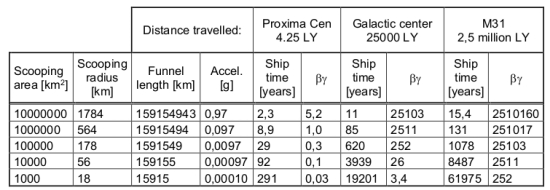
Table 1: Acceleration and travel time to Proxima Centauri, the galactic center, and the Andromeda galaxy M31, as a function of scooping area. ß? is the specific momentum at the given ship time. A ship mass of 1100 tons, reactor entrance radius 10 m, and constant acceleration from the start was assumed. During the starting phase the thrust is low, which increases the flight time by one to several years depending on the acceleration.
Fishback pointed out another problem of Bussard ramjets [5]. The magnetic field exerts strong outward Lorentz forces on the supraconducting coils. They must be balanced by some rigid support, otherwise the coils would break apart. When the ship gains speed, the magnetic field must be increased in order to keep the protons on track. Consequently, for any given mechanical support there is a cut-off speed beyond which the coils would break. For the Leonora Christina a coil support made of a high-strength „patented“ steel must have a mass of 1100 tons in order to sustain the magnetic forces that occur at ?=0,74.
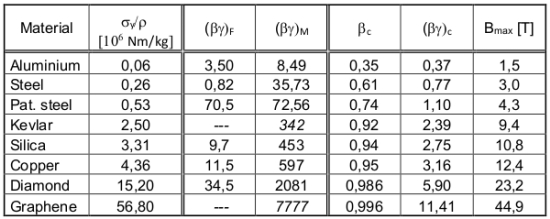
Table 2: Cut-off speeds ?c and cut-off specific momenta (ß?)c (upper bounds) for several support materials. (ß?)F from [5], (ß?)M from [7]. ?y/? is the ratio of the mechanical yield stress to the mass density of the support material. Bmax is the maximum magnetic field at the reactor entrance at cut-off speed. A scooping area of 10 million km2 was assumed, allowing a maximum acceleration of ~1 g for a ship of 1100 tons. Values in italics for Kevlar and graphene, unknown in the 1960s, were calculated based on equations given in [7].
But we assumed above that this is the ship‘s entire mass. That said, the acceleration must drop long before speeding at 0,74 c. The cut-off speed ?c=0,74 is an upper bound (for mathematicians: not necessarily the supremum) for the speed at which 1 g acceleration can be maintained. Lighter materials for the coil support would save mass. Fishback [5] calculated upper bounds for the speed at which an acceleration of 1 g is still possible for several materials such as aluminium or diamond (at that time the strongest lightweight material known). Values are shown in Table 2 together with (ß?)c.
Martin [7] found some numerical errors in [5]. Apart from that, Fishback used an optimistically biased (ß?)c. Closer scrutiny, in particular the use of a more realistic rocket equation [6], results in more realistic upper bounds. Using graphene, the strongest material known, the specific cut-off momentum is 11,41. This value would be achieved after a flight of three years at a distance of 10 light years. After that point, the acceleration would rapidly drop to values making it hopeless to reach the galatic center in a lifetime.
In conclusion, the interstellar magnetic ramjet has severe construction problems. Some future civilization may have the knowhow to construct fantastically long Fishback solenoids and to overcome the minimum mass condition. We should send a query to the guys who flashed the BLC1 signal from Proxima Centauri. The response is expected in 8.5 years at the earliest. In the meantime the educated reader may consult a tongue-in-cheek solution that can be found in my recent scientific novel [8].
Acknowledgements
Many thanks to Al Jackson for useful comments and for pointing out the source from which Poul Anderson got the idea for Tau Zero, and to Paul Gilster for referring me to the seminal paper of John Ford Fishback.
References
[1] Robert W. Bussard: Galactic Matter and Interstellar Flight. Astronautica Acta 6 (1960), 1-14.
[2] Poul Anderson: Tau Zero. Doubleday 1970.
[3] Carl Sagan: Direct contact among galactic civilizations by relativistic inter-stellar space flight, Planetary and Space Science 11 (1963) 485-498.
[4] Eugen Sänger: Zur Mechanik der Photonen-Strahlantriebe. Oldenbourg 1956.
[5] John F. Fishback: Relativistic Interstellar Space Flight. Astronautica Acta 15 (1969), 25-35.
[6] Claude Semay, Bernard Silvestre-Brac: The equation of motion of an interstellar Bussard ramjet. European Journal of Physics 26 (1) (2005) 75-83.
[7] Anthony R. Martin: Structural limitations on interstellar space flight. Astronautica Acta 16 (6) (1971) 353-357.
[8] Peter Schattschneider: The EXODUS Incident. Springer 2021,
ISBN: 978-3-030-70018-8. https://www.springer.com/de/book/9783030700188#aboutBook

Technosignatures: Enter the ‘Dataome’
I sometimes rely on nudges from my software to remind me of directions I’ve been meaning to take in a Centauri Dreams article. Seeing that Caleb Scharf has a new book out (The Ascent of Information), I was setting about ordering it when I noticed how many notes I had on my hard disk related to Scharf’s work, a reminder of how provocative I find his writings. That took me back to a 2018 article called The Selfish Dataome, and also to the recent article The Origin of Technosignatures, which appeared a few days ago in Scientific American.

Scharf (Columbia University) has the habit of asking questions no one else seems to have thought of. So let’s kick this around a bit. The notion of a ‘dataome’ is about external things that a species generates. Scharf defines it as:
a deeper way to quantify intelligent life, based on the external information that a species generates, utilizes, propagates and encodes in what we call technology—everything from cave paintings and books to flash drives and cloud servers and the structures sustaining them.
Here we go beyond biology to ask why technology comes to exist in the first place. But this gets into some deep philosophizing that is beyond my pay grade, so I’ll pause to look at the numbers in our current dataome, which are staggering. They inspire in me that punchy effect I can feel when contemplating galaxies full of stars and planets. In 2018, according to Scharf, we generated 2.5 quintillion bytes of data a day or — I like this — a billion billion bytes for every planetary rotation. Much of that data hangs around in our daily lives.
Think of YouTube’s holdings, for example, or the GIFs you occasionally get from your friends, the scientific papers we keep talking about in these pages, the emails that pester your bulging mailbox, the albums of photos of the kids in the family room, the collection of black and white movies on ancient VCR tapes (well, that’s my collection, but I assume you have something similar). This is all folded into a dataome, which to Scharf is analogous to a genome, and one that may, as per Richard Dawkins, somehow perpetuate itself. What compels us, in other words, to keep all these things?
To address the question in his older article, Scharf in 2018 looked at the writings of William Shakespeare. You’d think these would be easy to define: The gorgeous sonnets, the 37 plays, the 835,997 words comprising the complete works (with a small handful whose authorship is disputed). But the question is how all this has propagated over the centuries. Two to four billion physical copies, by Scharf’s estimates, of the works, meaning hundreds of billions of sheets of paper covered by more than a quadrillion letters, have been produced. All of this involves energy production, even in reading.
Thus Scharf on energy use:
Across time these billions of volumes have been physically lifted and transported, dropped and picked up, held by hand, or hoisted onto bookshelves. Each individual motion has involved a small expenditure of energy, maybe a few Joules. But that has added up across the centuries. It’s possible that altogether the simple act of human arms raising and lowering copies of Shakespeare’s writings has expended well over 4 trillion Joules of energy. That’s equivalent to combusting several hundred thousand kilograms of coal.
And that’s just for the physical production of the actual Shakepearean canon. Add this:
Additional energy has been utilized every time a human has read some of those 835,997 words and had their neurons fire. Or spoken them to a rapt audience, or spent tens of millions of dollars to make a film of them, or turned on a TV to watch one of the plays performed, or driven to a Shakespeare festival. Or for that matter bought a tacky bust of “the immortal bard” and hauled it onto a mantelpiece. Add in the energy expenditure of the manufacture of paper, books, and their transport and the numbers only grow and grow.
I have a lot of Shakespeare in the house myself. In addition to the various printed editions of his works I’ve accumulated since grad school, I also keep the Oxford and the recent Modern Library editions on my ebook readers (a Kindle Oasis and a Kobo Aura One). I like to think I’m saving a few trees: Scharf points out that given US paper production statistics (based on 2006 data), 28,000 Joules of energy were used per gram of final material. US paper production ran to 99.5 million tons of pulp and paper that year.
Here again the question of why we keep things: I read a lot of library books downloaded onto my e-readers. Talking this over with a bookish friend, he told me that wouldn’t work for him. He had to have a physical object on his shelf that he owned. Why?
If you think of this in terms of symbiosis, we are creating a burden of energy use to feed our dataome that continues to grow, and it’s a reasonable question to ask whether we are drawing the kind of benefit from it that we might. What are all those Facebook posts worth? But unlike our situation with the ‘selfish gene,’ this human-dataome symbiosis is something we can manage, even if we haven’t really examined its evolution or analyzed its function in the overall growth of the species. I assume this is what Scharf will be doing in his new book, which I will be discussing here later.
In the more recent article, though, Scharf questions whether these concepts have value in how we deal with technosignatures and the ongoing expansion of SETI toward artifacts and technologies. I’ve often thought in terms of the Drake Equation that the L factor — the longevity of a technological civilization — is embedded in the question of whether technology actually offers an evolutionary advantage. In the short term, the answer seems obvious, but not if the inevitable outcome of burgeoning high tech is putting tools of species destruction in the hands of an ever larger number of people.
Scharf argues that a search for technosignatures can be considered more broadly a search for extraterrestrial dataomes, for the former grow out of the latter. He suggests that we consider something like a Dyson sphere as a consequence of a process that is itself Darwinian:
…the arrival of a dataome on a world represents an origin event. Just as the origin of biological life is, we presume, represented by the successful encoding of self-propagating, evolving information in a substrate of organic molecules. A dataome is the successful encoding of self-propagating, evolving information into a different substrate, and with a seemingly different spatial and temporal distribution— routing much of its function through a biological system like us. And like other major origin events it involves the wholesale restructuring of the planetary environment, from the utilization of energy to fundamental chemical changes in atmospheres or oceans.
This plays into our plans to examine planetary atmospheres for environmental factors that could be the consequences of these kinds of energy transformations. Thus it would behoove us to consider the relationship between the dataome we move in and the biological life — ourselves — that interacts with it, questioning in what ways the interests of the two are aligned and where they may be coming out of joint. (Sorry, I had to get Hamlet in there, what with all this talk about Shakespeare: “The time is out of joint. O cursed spite, that I was born to set it right!” The Bard is timeless).
I’m not sure how we examine a balance like this in Darwinian terms, but we wrestle daily with consequences like social networks changing discourse and affecting public policy, or the widespread propagation of cultural memes via cable and streaming TV. Scharf sees carbon emissions as one consequence of the dataome’s insatiable demand for energy, so industrial pollution is an inevitable offshoot. I think we need to ask whether the idea of a dataome can offer us anything predictive about what another species might do as it encodes and propagates its own information.
Scharf asks the question in these essays but it’s clear we are only at the beginning of what may be a long conversation. I’m having trouble seeing how parsing the growth of data this way gives us tools beyond the factors we’re already using to search for technosignatures, but the key may be in the idea that a dataome resembles a living rather than an inert system. If genes can be selfish, can data be the same? Just how much control do we have over a dataome when it reaches planetary dimensions?
As we ourselves don’t know the outcomes of such growth, its manifestations in a technosignature will be hard to imagine. Let’s see where Scharf goes with this next.

Exoplanet Watch: Firming Up Transit Timing
Demonstrating once again the role amateurs can play in supporting ongoing observations, a new project linking NASA and the American Association of Variable Star Observers is being launched. Exoplanet Watch isn’t about discovering new transiting planets (although the potential is there) as much as tightening up the information we already have about planets currently under investigation. The idea is to help professional observers know when to look, which allows them to maximize precious observing time on instruments that are always in high demand.
Transit timing is the key, and the fact is that for many known exoplanets, knowing exactly when to look is problematic. Rob Zellem (JPL) is project lead for Exoplanet Watch:
“If there’s a 15-minute under-estimate of when a transit will occur, that’s an extra 15 minutes I have to build into my observing scenario. Time on big telescopes, especially space telescopes, is very, very precious. If you’re observing a lot of planets, [15 minutes] could add up to a substantial amount of time. Any time wasted means less science will be done with that telescope.”
Hubble’s recent difficulties only underscore the problems in equipment availability for this kind of work in space, but amateurs working with equipment down to 6-inch telescopes (supplemented with a digital camera attachment) can make a difference. Citizen scientists can observe transits, reduce and analyze the data, and upload results to the AAVSO’s Exoplanet Database, to be shared with the scientific community. After analysis via Exoplanet Watch, the results will be posted on the project’s website.
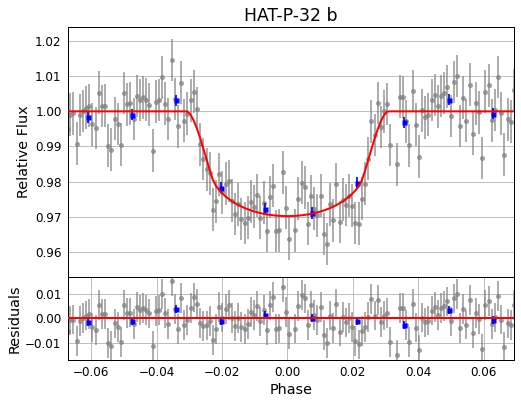
Image: An example lightcurve of the transiting hot Jupiter exoplanet HAT-P-32b as observed with a 6-inch (15.24-cm) MicroObservatory telescope in Tucson, Arizona. A transiting exoplanet periodically passes in front of its host star, causing the star to dim (and effectively casting a tiny shadow on the Earth!). The amount of light blocked by the planet tells us directly the size of the planet relative to its host star. Despite this target being relatively dim (V-mag = 11.44) and imprecise guiding on the target (the target drifted on the focal plane by ~100 pixels over the course of the observation), a single 6-inch telescope can achieve high precision transit observations. Credit: Zellem et al. 2020; citation below.
The heart of the process is the automated data pipeline called Citizen Initiated Transit Information Survey Enabling NASA Science (CITISENS), which pulls information from the AAVSO and calculates new ephemerides and orbital periods for each target submitted, tying in with data collected from the NASA Exoplanet Archive. Data input will be through the project’s EXOTIC (Exoplanet Transit Interpretation Code) software, which converts the information into the light curves at the heart of transit work.
While refined transit timing is a key objective of Exoplanet Watch, the project will also involve potential new discoveries as transit-timing variations reveal the presence of additional planets in a given exoplanet system. Newly observed planets can be tracked, helping in the confirmation process, while stellar variability, which can play havoc with a transit signal, can be monitored through an ever expanding dataset.
This is another win for amateurs with even modest equipment who want to make a contribution to exoplanet science. For background, the defining paper on Exoplanet Watch is Zellem et al., “Utilizing Small Telescopes Operated by Citizen Scientists for Transiting Exoplanet Follow-up,” Publications of the Astronomical Society of the Pacific, Volume 132, Issue 1011, id.054401 (May, 2020), 22 pp. (abstract).

Email Subscribers: Changeover Almost Complete
The redirection of Centauri Dreams posts for those of you who subscribe via email is just about finished. My apologies to those readers who received two different email copies of recent posts. We’re fixing that issue right now and I hope we’ll be finalized within a day or two. The changeover has been necessitated because of Google’s decision to stop supporting the Feedburner service that had previously supplied content via email.

Radiolytic H2: Powering Subsurface Biospheres
Although we’ve been focusing lately on photosynthesis, radiolysis — the dissociation of molecules by ionizing radiation — can produce food and energy for life below the surface and in deep oceans. Our interest in surface conditions thus needs to be complemented by the investigation of what may lie within, as Alex Tolley explains in today’s essay. Indeed, biospheres in a planet’s crust could withstand even the destruction of all surface life. The possible range of microorganisms well beyond the conventional habitable zone defined by liquid water is wide, and while detecting it will be challenging, we may be able to investigate the possibilities in our own system with landers, looking to a day when interstellar probes are possible to explore exoplanet interiors.
by Alex Tolley

“There may be only one garden of Eden here for large life forms such as ourselves. But living beings small enough to populate tiny pore spaces may well exist within several – and perhaps many-other planetary bodies.”
– Thomas Gold, The Deep Hot Biosphere, 1999 [1]
Thomas Gold was probably wrong about subsurface microbes being the source of fossil fuels using fossil methane (CH4), but he was the first to suggest that the newly discovered microbes in the Earth’s crust might be common in other planetary bodies. This essay will explore whether the molecules and energy available from the radiolysis of water (H2O) might support similar biospheres in other worlds in space.
Follow the water, but don’t forget the energy
NASA’s mantra of “follow the water” is important when searching for life, because liquid water is required for carbon-based terrestrial life. Life can still exist if the water freezes, but it will be in a non-metabolizing state and dormant. [Even in frozen water, such as the snow on mountains, a speck of dark material can melt a tiny volume of water around it, allowing microbes to live in these microscopic habitats.]
But while liquid water is necessary, it is insufficient to support life. Inoculate microbes in a dark, sealed flask of distilled water and they will die or go dormant, unable to acquire the energy needed for metabolism. [This is why you can keep containers of distilled water for a long time, even if bacteria contaminate the contents before sealing.]
The rich surface biosphere on Earth is powered by the sun. Photosynthesis fixes the sun’s energy from carbon dioxide (CO2) and water. Before photosynthesis evolved energy was anaerobically harvested from molecules that could liberate energy when respired. Bacteria living in the ocean’s dark, hot smoker vents metabolise the molecules erupting from the mantle and in turn provide the food and energy for the complex life living near these vents.
By the mid-1990s it was accepted that microorganisms discovered kilometers down in the crust were active in the interstices between the mineral grains. Water percolating in these rocks was responsible for keeping these microorganisms actively metabolizing rather than being in a dormant state. But what were they using for food and energy where it was lightless? Carbon was available as CO2 and CH4. The archaea kingdom of anaerobic organisms include all the methanogens that can convert CO2 to CH4 extracting energy and the using the carbon for metabolism. These were the dominant forms of life on and in the early Earth, and possibly the source of the traces of seasonal CH4 detected on Mars.
However, there is another more energetic molecule, molecular hydrogen (H2) that can be used for metabolism. As an electron donor, it can be coupled with an electron acceptor to be part of an energy harvesting metabolism. If H2 is a metabolic energy source, what is its source in the crustal biosphere?
The standard explanation is that some forms of the serpentinization reactions can produce H2 as well as the better known production of CH4.

However there is another source of H2, created by radiolysis of H2O by decaying radioactive elements such as unstable isotopes of potassium (K), thorium (Th), and uranium (U).


Figure 1. Radiolysis of water in the interstices of rock when water is present.
Besides creating H2, radiolysis also produces oxidants which in turn react with the rocks, most notably with sulfides, producing sulfates.
Li et al
“We have demonstrated that the S-MIF-bearing dissolved sulfate in the saline fracture waters at Kidd Creek originates from sulfides in the Archaean host rocks. The most likely mechanism for sulfate production in these anoxic fracture water systems is the indirect oxidation of sulfide minerals by oxidants from radiolytic decomposition of water” [3]
Radiolysis vs Serpentinization
Experiments on the radiolysis of water suggested that radiolysis was not an important source of H2 compared to serpentinization. Serpentinization occurs wherever high iron (Fe) igneous rocks from the mantle, water and heat interact. The ocean ridges between the plates are important zones where this takes place.
However, later experiments with oceanic sediments showed that radiolysis production of H2 was catalyzed by the minerals increasing production of H2 many fold. In the sediments on the ocean floor it was found that radiolysis was the main source of H2 as an energy source for microbes.
Sauvage et al: [9]
“Radiolytic H2 has been identified as the primary electron donor (food) for microorganisms in continental aquifers kilometers below Earth’s surface. […] all common marine sediment types catalyse radiolytic H2 production, amplifying yields by up to 27X relative to pure water. […] Comparison of radiolytic H2 consumption rates to organic oxidation rates suggests that water radiolysis is the principal source of biologically accessible energy for microbial communities in marine sediment older than a few million years.”
Moreover, radiolytic H2 is as dominant a source of food and energy as marine photosynthesis powered by the sun.
Sauvage et al: [10]
“[…] radiolytic H2 production in marine sediment locally produces as much electron donor (food) as photosynthetic carbon fixation in the ocean.”
In summary globally, radiolysis can provide both food and energy comparable to that of the marine photosynthetic organisms.
Methanogens & Sulfur-reducing bacteria
In anoxic environments where both archaeal methanogens and sulfur-reducing bacteria coexist, the biomass and types of the latter are greater than the former. One reason may be that the available energy from the reduction of sulphur from sulfates is greater than the reduction of carbon to CH4 from CO2.

CH4 can be created by the reduction of carbon dioxide.
![]()
Serpentinization is a geologic source. However, archaean methanogens are believed the dominant source of methane in the atmosphere on the early Earth reducing carbon dioxide anaerobically to methane [12]. It is the uncertainty of the source of the methane detected on Mars that intrigues astrobiologists.
Sulfate-reducing bacteria such as Desulfovibrio and Desulfobacter use the H2 to reduce sulfates created by the radiolysis oxidants on mineral sulfides to again reduce the sulfur to silfides.
![]()
As table 1 indicates, this is a more energetic reaction than methanogenesis and may account for the very many different bacteria utilizing H2 and sulphate as an energy source.The radiolytic oxidants also react with CH4 to form simple organic molecules such as formate and acetate which can be used as food sources by bacteria, further indicating the value of radiolysis in maintaining a subsurface habitat.
Habitability
As I have noted in previous posts, the search for life has typically been focused on surface-living, complex, aerobic life, as the low hanging fruit of detectability. This restricts the search to planets in the habitable zone (HZ). However, as unicellular life dominated Earth’s history and anaerobic respiration was dominant until the evolution of photosynthesis, and the Great Oxidation Event increased the partial pressure of oxygen in the atmosphere, such worlds may give rise to false negatives when analyzing the atmosphere by spectroscopy. Furthermore, as professor Tyrrell has suggested, surface life on Earth-like worlds may have a low probability of being sustained over 3 billion years due to events perturbing the surface temperature into runaway conditions.
Unlike the variable conditions on the surface, subject to wide ranges of conditions and vulnerable to cosmic and geologic disruption that saw 5 major extinctions on Earth, as well as an ongoing 6th extinction in the Anthropocene, conditions in the crust are far more stable, and less vulnerable to the disruptions on the surface. Such crustal biospheres once established may survive even after surface life has been extinguished, especially once the star’s luminosity renders the surface uninhabitable.
Such a biosphere may even allow for an evolutionary reset starting with microorganisms should surface conditions become uninhabitable for a temporary period and subsequently returning to habitability.
So we have evidence that life is in the subsurface crustal rocks and that radiolysis may be an important, if not the most important, source of food and energy for this life. But what about bodies elsewhere?
Other Celestial Bodies
1. Mars
Mars has all the same ingredients as Earth for subsurface microorganisms to live. At some depth below the surface the temperature should be sufficient to create liquid water [13]. While serpenitization can occur, especially to generate CH4, CO2 should be available for methanogens to respire and release CH4. Residual radioactive elements should be able to produce the needed H2 and SO4.for sulfur reducing bacteria. The race is on to determine whether there is an extant microbial biosphere on Mars. Looking for frozen microbes in ejecta from large meteor impacts that have penetrated to the needed depths might be the easiest approach for robotic vehicle discovery. If there are any near surface hot spots from residual volcanism or local concentrations of radioactive elements, these might also be good places to look. Whether earth, Venus, or Mars is the original world where abiogenesis occurred, panspermia between these worlds due to ejecta and microbes propelled by solar radiation, early Mars may have been a home for life.
Tarnas et al: [14]
“We have demonstrated that radiolysis alone produced sufficient quantities of reductants to have sustained a subsurface biosphere during the Noachian for hundreds of millions of years. Given sufficient oxidant availability, this habitat could have fostered chemolithotrophic microbial communities that would have imprinted organic, morphological, and isotopic biosignatures on their habitat’s host rock.”
2. Icy moons
Jupiter’s Europa and Saturn’s Enceladus are 2 icy moons that have subsurface oceans and tidally induced warming. Radiolysis of subsurface water in the core below the ocean sediments should provide the conditions necessary for a microbial biosphere. Analysis of the plumes by a flyby or orbiting probe is one method to search for life, although this is more likely to detect life in the oceans, rather than below the ocean-crust interface. This later will prove a much more difficult target.
3. Titan
Saturn’s moon Titan is believed to have a rocky core, overlaid with a liquid ocean, and topped with hydrocarbons with a dense nitrogen atmosphere. As with the icy moons, below the crust-ocean interface is a possible biosphere.
4. Ceres
Like the icy moons, Ceres has a rocky core overlaid with brines. Evidence of cryovolcanism suggests that these brines must be partially liquid. Unlike the icy moons, there is no tidal heating. This suggests that any biosphere in the core must be powered by radiolysis from any residual radioactive element decay. Catillo-Rogers recently suggested Ceres has the potential to host life as it has the radioactive elements for both heating and radiolysis. [5]
5. Eris
The Trans-Neptunian dwarf planet Eris has a density of 2.52 g/cm^3, indicating that it must be composed of rocky material and ices. If, like Pluto, there is evidence of cryovolcanism then it is possible that a core with radioactive elements and liquid water provides a habitat for a microbial biosphere. If so, then other dwarf planets extending out into the Kuiper belt could also have similar subsurface habitats.
6. Comets and Kuiper belt Objects
Holm focused on serpentinization for the production of CH4 and H2 on celestial bodies [7] He notes that radioactivity could also warm these bodies, making serpentinization possible. However, he did not consider radiolysis that might have been an important contribution to the production of energy rich molecules that could be used for metabolism.
Comets and their parent bodies, such as Transneptunian Objects (Kuiper Belt Objects—KBOs), accreted from a mixture of volatile ices, carbonaceous matter, and rocks in the coldest regions of the protosolar nebula. […] However, the rocky material contained in comets includes radioactive isotopes, whose decay can provide an important source of heat, possibly significantly altering the internal structure of these icy objects after their formation. There is a general agreement that short-lived radioactive isotopes like 26Al and 60Fe could have played a major role during the early evolution of both comets and their parent bodies, possibly leading to the melting of water ice and to the triggering of serpentinization and FTT reactions.
A more recent paper by Bouquet emphasized the importance of radiolysis in icy bodies which not only produced H2, but sulfates to support metabolism [2].
We found that radiolysis can produce H2 quantities equivalent to a few percent of what is estimated from serpentinization. Higher porosity, which is unlikely at the scale of a body’s entire core but possible just under the seafloor, can increase radiolytic production by almost an order of magnitude. The products of water radiolysis also include several oxidants, allowing for production of life-sustaining sulfates. Though previously unrecognized in this capacity, radiolysis in an ocean world’s outer core could be a fundamental agent in generating the chemical energy that could support life.
7. Rogue/Free Floating Planets
Rogue planets ejected from their systems would include bodies similar to those in the solar system. Given the prevalence of conditions needed for a subsurface biosphere, especially in bodies at the edge of our system, there seems every reason to believe that these rogue planets should also host subsurface conditions suitable for a microbial biosphere.
Habitable yes, but inhabited?
The above suggests that if radioactive elements can also heat the surrounding material so that water is kept liquid, then almost any celestial body with a rocky material and water could potentially be a microbial habitat in space, irrespective of whether it is in the HZ or not. As suggested earlier, planets in the HZ that have lost surface habitability could retain refugia for life in the crust.
For other non-Earth-like bodies which may have the conditions for a subsurface biosphere the question becomes whether they are living or sterile. Is abiogenesis possible on these worlds, or must they be inoculated by life from living worlds? We don’t yet know the answers to such questions, but it does suggest that astrobiologists take seriously the possibility that any body with a suitable subsurface environment could be inhabited and therefore instruments to detect such life should be included with exploratory probes. As we increase the exploration of our system, landers and rovers should include technologies to detect life, especially within the habitable zone below the surface.
Could we detect subsurface biospheres on exoplanets?
Detection of subsurface biospheres on exoplanets is going to be very difficult. Seager [6] produced a catalog of possible biosignature molecules, of which hydrogen sulphide (H2S) is primarily of biologic origin and therefore its presence is likely an unambiguous biosignature.
Although H2S is likely to have a very low concentration in the atmosphere it has a distinctive IR signal which could be detectable in principle,
As we can currently only analyze exoplanets spectroscopically, if it becomes possible to detect the very small amounts H2S in an otherwise unpromising atmosphere with possibly unsuitable surface conditions for life, then we should attempt to devise the technology to detect the presence of this gas as an unambiguous biosignature.
Based on the terrestrial history of life, it seems likely that on living exoplanets, extant life will be mostly unicellular, possibly even just prokaryotes. On Earth-like worlds geologic processes will ensure that such life will also inhabit a deep, crustal biosphere. Detecting such life will be very difficult, but perhaps not impossible with suitable technology. In the distant future, interstellar probes with landers should be able to detect such life as we explore our stellar neighborhood and catalog and map the forms of life we find.
References
Gold, T. (2021). The Deep Hot Biosphere: The Myth of Fossil Fuels (November 6, 1998) Hardcover. Springer.
Bouquet, A., Glein, C. R., Wyrick, D., & Waite, J. H. (2017). Alternative Energy: Production of H 2 by Radiolysis of Water in the Rocky Cores of Icy Bodies. The Astrophysical Journal, 840(1), L8. https://doi.org/10.3847/2041-8213/aa6d56
Li, L., Wing, B. A., Bui, T. H., McDermott, J. M., Slater, G. F., Wei, S., Lacrampe-Couloume, G., & Lollar, B. S. (2016). Sulfur mass-independent fractionation in subsurface fracture waters indicates a long-standing sulfur cycle in Precambrian rocks. Nature Communications, 7(1). https://doi.org/10.1038/ncomms13252
Lin, L. H., Wang, P. L., Rumble, D., Lippmann-Pipke, J., Boice, E., Pratt, L. M., Lollar, B. S., Brodie, E. L., Hazen, T. C., Andersen, G. L., DeSantis, T. Z., Moser, D. P., Kershaw, D., & Onstott, T. C. (2006). Long-Term Sustainability of a High-Energy, Low-Diversity Crustal Biome. Science, 314(5798), 479-482. https://doi.org/10.1126/science.1127376
Castillo-Rogez, J. C., Neveu, M., Scully, J. E., House, C. H., Quick, L. C., Bouquet, A., Miller, K., Bland, M., De Sanctis, M. C., Ermakov, A., Hendrix, A. R., Prettyman, T. H., Raymond, C. A., Russell, C. T., Sherwood, B. E., & Young, E. (2020). Ceres: Astrobiological Target and Possible Ocean World. Astrobiology, 20(2), 269-291. https://doi.org/10.1089/ast.2018.1999
Seager, S., Bains, W., & Petkowski, J. (2016). Toward a List of Molecules as Potential Biosignature Gases for the Search for Life on Exoplanets and Applications to Terrestrial Biochemistry. Astrobiology, 16(6), 465-485. https://doi.org/10.1089/ast.2015.1404
Holm, N., Oze, C., Mousis, O., Waite, J., & Guilbert-Lepoutre, A. (2015). Serpentinization and the Formation of H2 and CH4 on Celestial Bodies (Planets, Moons, Comets). Astrobiology, 15(7), 587-600. https://doi.org/10.1089/ast.2014.1188
Lollar, B. S., Onstott, T. C., Lacrampe-Couloume, G., & Ballentine, C. J. (2014). The contribution of the Precambrian continental lithosphere to global H2 production. Nature, 516(7531), 379-382. https://doi.org/10.1038/nature14017
Sauvage, J. F., Flinders, A., Spivack, A. J., Pockalny, R., Dunlea, A. G., Anderson, C. H., Smith, D. C., Murray, R. W., & D’Hondt, S. (2021). The contribution of water radiolysis to marine sedimentary life. Nature Communications, 12(1). https://doi.org/10.1038/s41467-021-21218-z
Sauvage, J. F., (2018) Sedimentary Catalysis of Radiolytic Hydrogen Production, Open Access Dissertations. Paper 704. https://digitalcommons.uri.edu/oa_diss/704
Cepelewicz, J, (2021, May 24). Radioactivity May Fuel Life Deep Underground and Inside Other Worlds, Quanta Magazine, Accessed online June 2021 https://www.quantamagazine.org/radioactivity-may-fuel-life-deep-underground-and-inside-other-worlds-20210524/
Tolley, A., Detecting Early Life on Exoplanets. February 23, 2018
https://www.centauri-dreams.org/2018/02/23/detecting-early-life-on-exoplanets/
Tolley, A., Is Most Life in the Universe Lithophilic? – AMT prior article JANUARY 11, 2019 https://www.centauri-dreams.org/2019/01/11/is-most-life-in-the-universe-lithophilic/
Tarnas, J., Mustard, J., Sherwood Lollar, B., Bramble, M., Cannon, K., Palumbo, A., & Plesa, A. C. (2018). Radiolytic H2 production on Noachian Mars: Implications for habitability and atmospheric warming. Earth and Planetary Science Letters, 502, 133-145. https://doi.org/10.1016/j.epsl.2018.09.001

